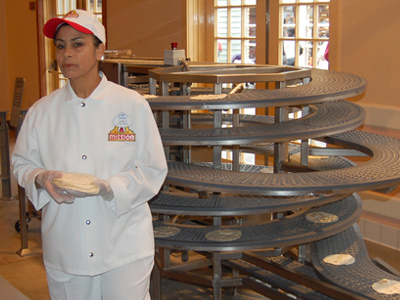
First invented by the Mayans more than 10,000 years ago, tortillas have become a $6 billion a year industry in the U.S. alone.
Tortillas have surpassed bagels and muffins, to come only second in place to sliced bread, and have now become the number 2 packaged bread product sold in the U.S. The rapid growth of the tortilla industry is attributed not only to the growing Hispanic population, but to increasing tortilla consumption among non-Hispanics as well.
“Half of my clients are Mexican and the other half are from different nationalities including Anglos and Asians,” said Susy Collazo, owner of Mexico Tortilla Factory & Delicatessen en Newark. “Mexican food is very popular. People come to the store with their recipes and buy the ingredients and the tortillas.”
In 1519, Hernan Cortes and his conquistadores arrived in the New World (modern-day Cuba and Mexico). In 1520, in Cortes second letter to the King of Spain, he describes public squares where daily markets were held and attended by thousands of people that bought and sold a great variety of merchandise and foods. Among the foods that he described were Indian corn (maize) in grains and in the form of flat corn bread. This corn bread was later given the name "tortilla" by the Spanish.
In 1529, the Franciscan friar Bernardino de Sahagun described how the Aztec diet was based on corn, tortillas, tamales and a wide variety of chilies. Tortilla making by the Indians of Mexico 400 hundred years ago started with a golf ball size piece of dough that was patted down by hand and into a thin pancake shape. It was then placed onto a hot griddle (comal) and cooked on both sides. This tortilla making process is still in use today.
Today, personal and industrial tortilla making equipment facilitate and expedite the tortilla making process. Manually operated wooden tortilla presses of the past have led to today's industrial tortilla machinery which can produce thousands of tortillas per minute.
In the U.S., tortillas have now grown from an ethnic to a mainstream food. Tortillas are gaining popularity and market share in other countries as well. In order to better serve the growing tortilla market in Asia, Gruma, the world's largest producer of tortillas and corn-based flour, recently invested hundreds of millions of dollars opening two tortilla making plants in China and Japan. Gruma also has tortilla plants in Mexico, Central America, Venezuela, Great Britain, Italy and the United States.
“Tortillas are having a big demand in their consumption not only because the Hispanic community is growing,” said Caren Rocha, financial manager of La Finca Tortillería in Oakland. “Other cultures are choosing corn tortilla over white bread or flour tortilla because it is healthier.”

